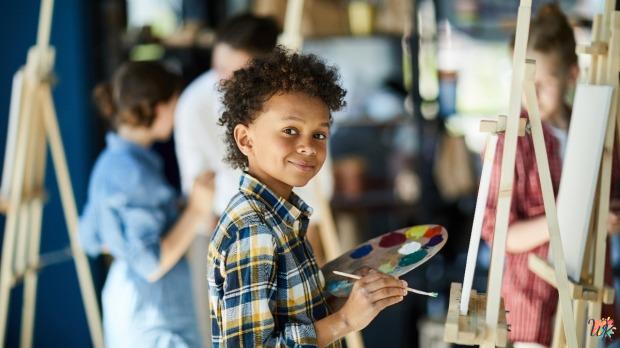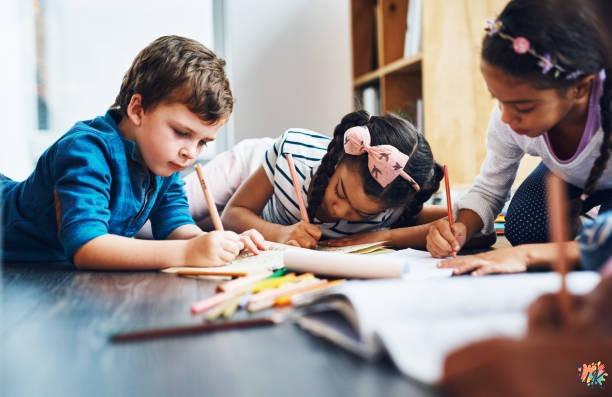This blog focuses on the significance of coloring in the development of children. It aims to emphasize the benefits of encouraging children to color and highlights how coloring can enhance their imagination, creativity, and cognitive development. Additionally, it can also improve their fine motor skills.
Understanding Children’s Preferences
Recognizing a child’s individual interests and themes is important when it comes to coloring. By understanding what a child is passionate about, we can select coloring pages and activities that will engage their attention and make the process enjoyable for them. This can lead to a more positive experience and encourage them to continue exploring and creating through coloring.

Creating an Inviting Coloring Environment
Please outline the process of creating a personalized coloring area that is both comfortable and encourages creativity. Additionally, please consider selecting appropriate coloring supplies, such as high-quality coloring books with engaging designs, colored pencils, and crayons.
Making Coloring Interactive
Organizing coloring sessions with friends and family has numerous benefits. It creates an opportunity for children to share their ideas and collaborate on coloring projects, fostering social skills and teamwork. Incorporating storytelling and imagination into coloring sessions encourages children to create narratives and bring their pictures to life, helping to develop their creativity and critical thinking skills.
Exploring Different Coloring Techniques
One way to enhance children’s coloring skills is by introducing shading and blending techniques to them. Another approach is to vary the coloring mediums they use, such as colored pencils, markers, or watercolors, which can offer different experiences and broaden their artistic abilities.
Incorporating Learning and Education
Coloring can be a great way to connect educational topics like letters, numbers, or animals. By coloring, children can learn and develop their knowledge while enjoying the process. Coloring helps in facilitating learning, encouraging discussions, and enhancing creativity. For instance, coloring can help children learn the alphabet by associating letters with specific objects that they can color. Similarly, coloring animal pictures can help teach children about different animals and their characteristics. Furthermore, coloring can be an excellent tool for developing fine motor skills and hand-eye coordination.
Incorporating Technology in Coloring
One advantage of using digital coloring apps and websites alongside traditional coloring methods is that they provide interactive features and more coloring options that can help children explore their creativity in the digital world. This can make coloring a more engaging and enjoyable experience for them. Additionally, digital coloring apps and websites can offer a wider variety of colors and tools that are not available with traditional coloring methods. By using these digital tools, children can create unique and imaginative pieces of art that they may not be able to achieve by using regular coloring materials alone.
Inspiring Creativity through Coloring Challenges
Exploring creative outlets like organizing coloring challenges and competitions can motivate children to think beyond boundaries and unleash their imaginations. It is crucial to encourage experimentation and foster an encouraging environment that enables them to showcase their distinctive artistic expressions. By doing so, children can tap into their creativity and come up with unique and innovative ideas to excel in their artistry.
Embracing Cultural Diversity in Coloring
Exploring coloring traditions from different cultures is important because it helps children broaden their understanding of various cultures, and appreciate the diversity of different societies. Celebrating diversity through coloring activities can promote inclusivity, and foster an appreciation for a range of artistic styles. When children are exposed to different cultural traditions through coloring, they may also develop a deeper sense of empathy and understanding for people who come from different backgrounds than their own. Overall, learning about coloring traditions from diverse cultures can help children develop a more global perspective and promote cross-cultural understanding.
Encouraging Self-Expression and Originality
Exploring creativity and self-expression in coloring is crucial for children. Allowing them to interpret and express their ideas in their unique way helps in developing their artistic identity and enhances their confidence. Therefore, it is important to support children in coloring according to their own imagination and creativity to achieve these benefits.

Nurturing a Positive Coloring Mindset
Coloring can play a significant role in boosting self-confidence and self-esteem. It is essential to develop a positive attitude towards mistakes and imperfections while coloring to foster a healthy mindset. The process of coloring should be given more importance than achieving perfection. This approach helps individuals to become comfortable with their mistakes and learn from them, which ultimately boosts their confidence.
Incorporating Coloring into Everyday Life
Incorporating coloring into daily routines and activities can be done in various ways, such as setting aside coloring time before bedtime or during family gatherings. Coloring is known to be a great tool for relaxation and stress relief, and can also become an opportunity for quality bonding time.
Summary
The article discussed five ways to help children enjoy coloring pictures. These include providing various materials, letting children choose their own pictures, praising their efforts, displaying their artwork, and making it a fun activity. Coloring plays an important role in child development, fostering creativity, cognitive skills, and emotional well-being.
Frequently Asked Questions (FAQs)
What age is suitable for introducing coloring to children?
It’s a good idea to start introducing the activity of coloring to children when they are two or three years old. You can start with simple coloring activities using large crayons or finger paints. As they get older, they can gradually move on to more complex coloring tasks.
How can I encourage a child who shows no interest in coloring?
Not all children may enjoy coloring at first, but you can motivate them to participate by providing different coloring tools, themes, and techniques. Try using their favorite objects or characters in coloring pages to get them excited. You could also explore other creative activities like painting, sculpting, or drawing to encourage their artistic expression. Remember that every child is unique in their own way.
Are there any benefits to coloring for children with special needs?
For children with special needs, coloring can have many advantages. It can improve their sensory integration, fine motor skills, and help them relax. It’s important to tailor coloring activities to their specific needs, which could include using special tools or adjusting the difficulty level of coloring pages. You may want to consult with therapists or educators for individualized suggestions.
What are some safety considerations when children are coloring?
Make sure to prioritize safety when children are coloring. You can do this by using coloring materials that are non-toxic and appropriate for their age. Teach children how to handle art supplies properly, such as not putting them in their eyes or mouth. To minimize fume exposure, provide a well-ventilated area for coloring. Be sure to supervise young children to avoid accidents or misuse of materials.
Can coloring help improve a child’s fine motor skills?
Coloring is a great way to improve children’s fine motor skills. By using coloring tools, they can enhance their hand-eye coordination and develop stronger hand muscles. This can also improve their handwriting, dexterity, and overall coordination as they continue to practice coloring.
Conclusion
To sum up, encouraging children to color is a priceless way to support their creativity, imagination, and cognitive growth. Parents and caregivers can provide a fulfilling coloring experience by knowing their preferences, making a welcoming space, including interactive elements, trying varied techniques, and connecting coloring to education.Coloring has many benefits, including promoting diversity, self-expression, and positivity. Incorporating it into daily life can enhance these benefits. Parents can unlock the full potential of coloring by encouraging their children to engage in this activity. Let’s embrace coloring and watch our children’s creativity soar!
Remember, each child is unique, so adapt these strategies to suit their individual needs and interests. Happy coloring with ColoringPagesWK!

